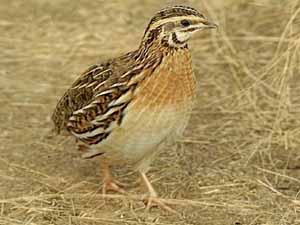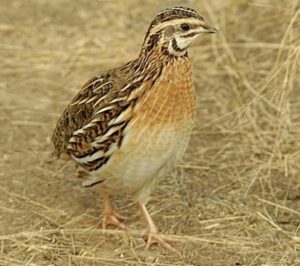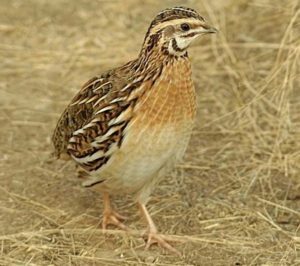The Japanese quail is the most common species of鹌鹑主要在东亚发现。它被认为是普通鹌鹑的亚种,但在1983年被认为是自己的物种。自12世纪以来,日本鹌鹑在人类的生活中发挥了积极作用。
And it is still playing very important and major roles in industry and scientific research. These birds are abundant across most of their range, where they are found. And currently there are a few true breeding mutations of this quail species.
The Japanese quails are actually the domesticated forms of the common quails. The earliest records of domesticated populations of this breed are from Japan during the 12th century.
虽然,有证据表明该物种实际上早在11世纪就被驯化了。以前,这些鸟被繁殖为鸣禽,人们认为它们是在歌曲比赛中定期使用的。
Japanese breeders began to selectively breed these birds in the early 1900s for increasing egg production. And the industry surrounding鹌鹑eggswas flourishing by 1940.
The events of Second World War led to complete loss of quail lines bred for their song type, as well as almost all of those bred for egg production. The few quails left after the war, were used to rebuild the industry.
And all the commercial and laboratory lines available today are considered to have developed from this population of quails.
Populations of the Japanese quails are known to inhabit mainly俄罗斯和East Asia (including China, India, Japan and Korea).
They are also available and found in some other Asian countries such as Cambodia, Laos and Vietnam. They are also found in some African countries such asKenya, Madagascar, Namibia, Malawi and Tanzania.
Currently there are a few true breeding mutations of these birds. The breeds from theUnited Statesare: English White, Italian, Golden range, Golden Tuxedo, Manchurian, Tibetan, Texas A&M, Red Range, Rosetta, Roux Dilute and Scarlett. However, read some more information about this quail breed below.
Table of Contents
Japanese Quail Characteristics
The Japanese quail is a beautiful bird. The morphology of this bird differs depending on it’s stage in life. Both male and female chicks exhibit the same kind of plumage and coloring.
Their heads are tawny in color, with small back patches littering the area above the beak. They have a pale yellow-brown stripe surrounded by smaller black stripes runs down the top of the head.
小鸡的翅膀和背面是浅褐色的颜色。背面有四个棕色条纹沿其长度延伸。
Plumage of the adult Japanese quail is different depending on the gender, allowing for differing male and females from one another.
雄性和女性都有主要的棕色羽毛。但是,喉咙和乳房上的标记以及羽毛的棕色特定阴影可能会有很大差异。
The breast feathers of the male show off a uniform dark reddish-brown color that is devoid of any dark spots. While the female’s breast feathers are littered with dark spots among generally pale feathers.

The cheek feathers of the female are more cream colored, but the male’s cheek feathers are reddish-brown. Sometimes, some males also exhibit the formation of a white collar, but this doesn’t occur in any female Japanese quail.
In case of size, the male Japanese quail tend to be smaller in size than the females. The domesticated birds generally weight between 100 and 120 grams (the wild birds generally weight less than the commercial variety, and they weight between 90 and 100 grams).
Although, weight of the domesticated lines can vary, and the commercial strains which are used for meat production can reach up to 300 grams. Photo and info from维基百科.
用途
他们的日本鹌鹑是一种双重用途的家用鹌鹑。它是针对鸡蛋和肉类生产而饲养的。
Special Notes
The Japanese quail is mainly a ground-living species that tends to stay within the areas of dense vegetation in order to take cover and evade predation.
Natural habitats of these birds include bushes along the banks of rivers, grassy fields, and agricultural fields that have been planted with crops such as rice, barley and oats.
It has also been reported to prefer open habitats such as meadows, mountain slopes near a water source and steppes.
Diet of the Japanese quail includes many different types of grass seeds. They also feed upon a variety of insects, larvae and other small invertebrates.
They generally eat and drink at the beginning and end of the day. But they can also eat and drink throughout the day in商业农场conditions.
在繁殖的情况下,日本鹌鹑在夏季显示出峰值繁殖活动(当测试的大小和睾丸激素浓度的增加时,其峰值达到了高峰)。
These birds are excellent egg layers. They tend to lay eggs in the few hours preceding dusk. Their eggs are generally mottled with a background color ranging from white to blue to pale brown.
The eggs can weight from 8 to 13 grams depending on the strain, and the older females tend to lay much larger sized eggs. Domesticated lines of the Japanese quail can lay up to 300 eggs a year at a very efficient feed to egg conversion ratio.
Today, the Japanese quails are raised as a dual-purpose birds. And they are raised for both meat and eggs production. They are easily managed birds and grow relatively faster.
今天,他们主要在商业广告中长大farmsthroughout the world. Their meat and eggs are considered very good for consumption compared tochickens和ducks. However, review full breed profile of the Japanese quail in the following chart.
| Breed Name | Japanese |
| 其他名称 | None |
| Breed Purpose | Dual-purpose (meat and eggs) |
| Special Notes | Very strong and hardy birds, active, generally a ground-living species, natural habitats of these birds are river of banks, grassy fields and agricultural fields, grow relatively faster, generally eat and drink at beginning and end of the day, although the birds in commercial farms can eat throughout the day, summer is the peak breeding season for these birds, these birds are excellent egg layers, today raised for both meat and eggs production |
| Species | Old World Quail |
| Weight | 一般100 - 120克,but the commercial lines can weight up to 300 grams |
| Climate Tolerance | Almost all climates |
| Egg Color | Generally mottled with a background color ranging from white to blue to pale brown |
| Egg Size/Weight | 8至13克 |
| Egg Productivity | 根据驯化线,每年最多300个鸡蛋 |
| Color | Brown with markings |
| Rarity | Common |
| 国家/起源地 | East Asia |






